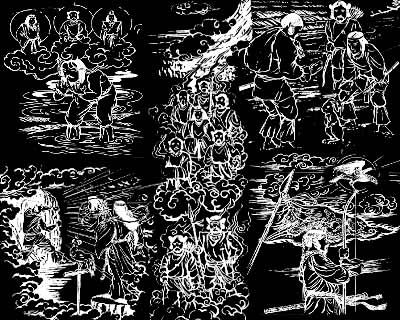Shinto is Japans ügoriginalüh religion. It is very similar to old european and Northasian religions. It worships an imense variety of deitys called Kami , some are nature spirits, some are ancestors or heroes. Like in North-Europe the divine was Revered in nature. A grove of trees or a mountain was the meeting between man and his gods. There were no images of the divine in human form. Later simple structures were erected and a symbol ( not an image ) of the kami placed there for worship. Suchü@éhéŹéüéçéůéô were only introduced after the arrival of buddhism. Early shinto shrines were build in simple Style, looking much like farmhouses. The Idea of purity was evident in early times and may be an original concept. With the introduction of buddhism Shinto faced many challenges, just as in europe cristianity took old heathen custums,and merged them with the new religion buddha and shinto became one. After that came varios attempts to seperate them. Shintoism has no structured congregational worship. However, the connecting force is the "kami" translated as "natural deity". Shinto followers honour "musuhi" which are the Kami's creative and harmonising powers. The will of the Kami is obtained through "makoto" (sincerity or true heart). The Shinto virtues are repercussions of makoto; they view morality as kindness and unselfishness that will benefit the whole. The Sun Goddess is regarded as the chief deity, but the Shinto also revere several other spirits which symbolise things of nature and support the Kami.

The Shinto's sacred shrines, whether it be a waterfall or an emaculate building, are dedicated to a specific Kami. Here shrine ceremonies are performed. The ceremonies may include washings, prayers, offerings, and dances which are all directed to the Kami for his blessings. Seasonal services are held at harvest time, planting time, and on special holidays. There are "Four Affirmations" in the Shinto belief system. They are as follows: 1) tradition and family, 2) love of nature, 3) physical cleanliness, and 4) "matsuri". The family is viewed as the primary force in the preservation of customs. Shinto spirits and deities are founded upon natural objects. A sound relationship with nature insures a sound relationship with the Gods. Physical cleanliness is displayed by frequent bathing, hand washing, and mouth rinsing. Lastly, the "matsuri" is a festival which honours the Shinto spirits. There are variations of these beliefs in the different branches of Shintoism. However, they all follow these basic truths.Most people will often think of shinto as nationalistic movement, like the old germanic faith it was misused to imperialistic war making. Today shinto is a tradition involved in japanese life. There is not much interest in religion among younger people. Big shrines attract many people, and so do big festivals, but there seema to be a lack of understanding the faith.Shrines make money be performing ceromonies such as weddings or by selling charms and fortune tellingpapers
Those are bound to a tree here. Alltogether the comercial aspect is strong, any ritual costs. Many people I have talked to assosiate Shinto with imperialism and fashism and I must confirm this after my own experiences in Japan. This is one big obstacle Shinto needs to overcome in order to have future.
Shinto has more than one type of worship. Some of those
categories are Tennoism, Imperial Family Shinto, and Household Shinto. Tennoism is the notion that the Emperor has the embodiment of the Sun Goddess in him. Hence, he has total authority ov er anyone. He has four shrines on his land. The shrines are Kashiko-dok oro, Korei-den, Shin-den,and Shinka-den.
The Kashiko-dokoro shrine was built to honor Amaterasuomikami while the korei-den shrine was made to honor the previous Emperors.
The Shin-den was dedicated to the eight myriads of the Gods'. The conclusive shrine did not have a specific element to idolize.
Household Shinto is worship at one's home.
Worshipers of this type of shinto use a small shrine inside
their house.
There,some will conduct private services such as
commemorating
ancestors.
This is a household shrine.
Portable shrine at a festival(matsuri)

